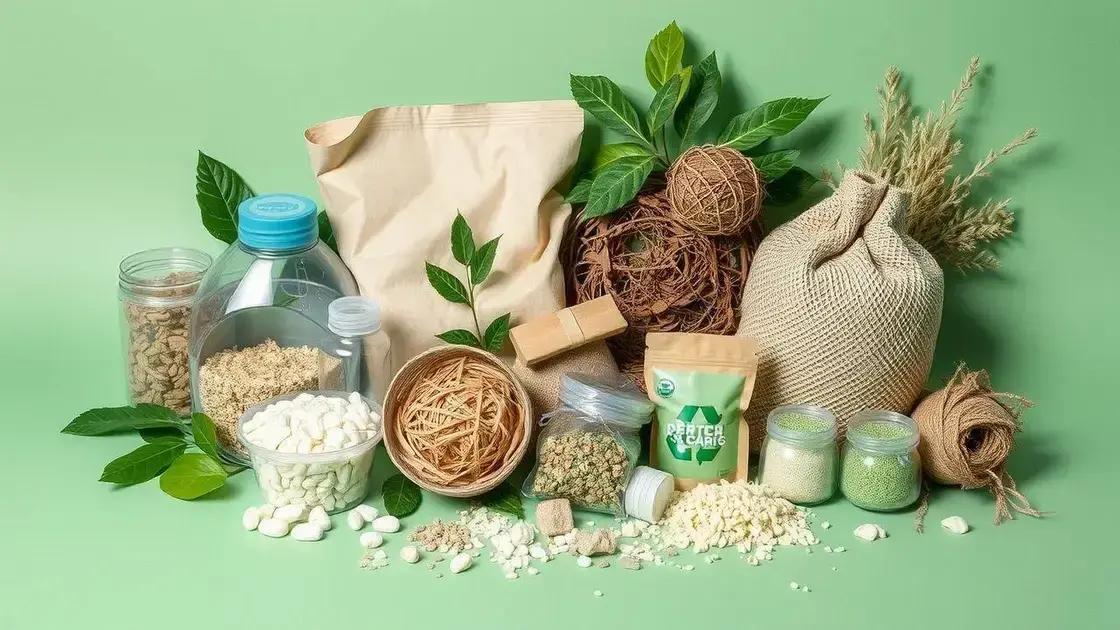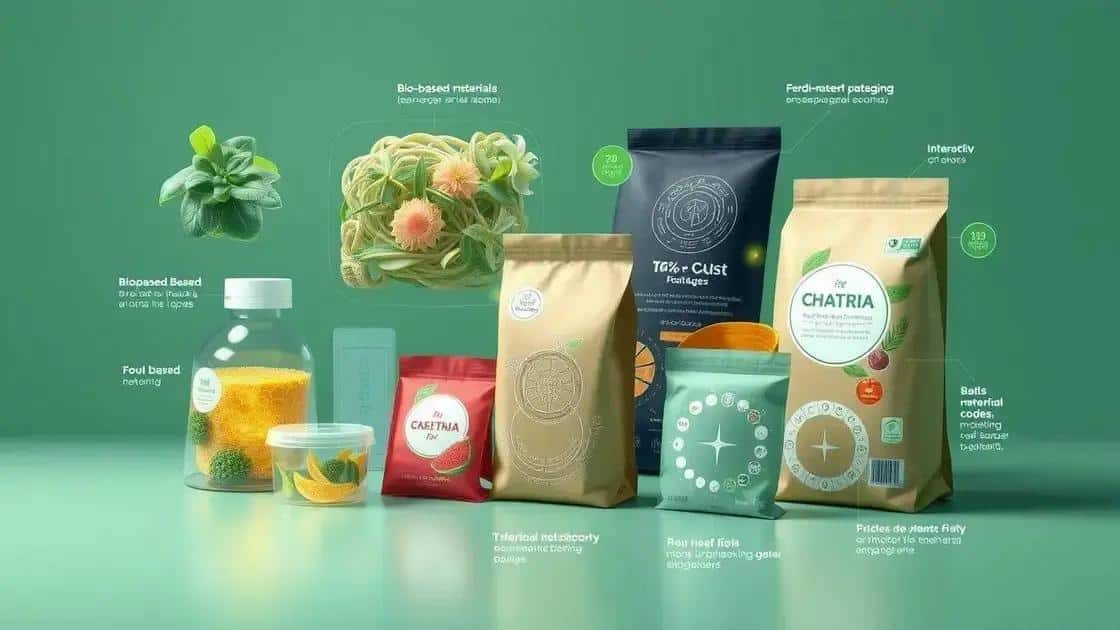Sustainable packaging news trends: what you need to know

Sustainable packaging news trends highlight innovations like eco-friendly materials, smart packaging, and consumer demand for transparency, shaping the future of environmentally responsible packaging solutions.
Sustainable packaging news trends are emerging rapidly, shaping how products are delivered to consumers. Curious about how these changes affect your choices? Let’s dive into the latest developments!
Current innovations in sustainable packaging
The world of packaging is rapidly evolving, especially with sustainable packaging taking center stage. Innovations are making packaging not only more eco-friendly but also cost-effective and practical.
Recent Advancements
Companies are investing in research and development to discover new materials that minimize environmental impact. For instance, biodegradable plastics are becoming more common, breaking down naturally without leaving harmful residues.
Key Materials
Some notable materials include:
- Paper-based solutions that use recycled content.
- Plant-based plastics made from renewable resources.
- Edible packaging that reduces waste completely.
These developments are not just limited to materials. Designs are also changing. Packaging shapes that allow for stacking reduce transportation costs and emissions. By rethinking how products are packaged, companies aim to create less waste overall.
Moreover, innovations like smart packaging are gaining traction. This technology allows brands to track the freshness of their products, reducing spoilage and ensuring that consumers receive the highest quality items. Consumers appreciate being informed and engaged with the products they buy.
Future Outlook
Looking ahead, the trend points towards even more sustainable innovations. Companies may begin to use closed-loop systems where packaging is returned and reused. This not only minimizes waste but creates a circular economy that benefits both businesses and the environment.
Benefits of using eco-friendly materials

Choosing eco-friendly materials offers numerous advantages for both the environment and businesses. When companies make the switch to sustainable options, they not only contribute to the planet’s health but also appeal to a growing base of environmentally conscious consumers.
Environmental Impact
One of the most significant benefits is the positive impact on the environment. By using materials that are biodegradable or recyclable, companies help reduce the amount of waste sent to landfills. This approach also conserves natural resources, ensuring that future generations have access to the materials they need.
Consumer Preference
Today, many shoppers actively seek out products made from sustainable materials. Research shows that consumers are willing to pay more for items that are environmentally friendly. This trend benefits brands that prioritize sustainability, allowing them to stand out in a crowded market.
- Enhanced brand loyalty is often a result of demonstrating a commitment to sustainability.
- Positive brand image can attract new customers.
- Increased sales may follow as eco-conscious consumers share their experiences.
Furthermore, using eco-friendly materials can lead to cost savings in the long run. Although some sustainable materials may have a higher initial cost, companies often find that the reductions in waste disposal costs and the potential for government incentives make it a financially sound choice.
By opting for sustainable packaging, businesses can also benefit from improved operational efficiency. For instance, packaging that is lighter can reduce shipping costs, while materials that protect products better can lead to fewer damages. This ultimately enhances customer satisfaction and loyalty, strengthening the business-client relationship.
Consumer preferences for sustainable packaging
Understanding consumer preferences for sustainable packaging is essential for businesses aiming to thrive in today’s eco-conscious market. As more consumers prioritize the environment, their choices heavily influence packaging trends.
Shifting Attitudes
Many shoppers are becoming aware of the impact that packaging has on the environment. Consequently, they are inclined to choose products with eco-friendly packaging. Studies indicate that a significant percentage of consumers are willing to switch brands if they find a product with better sustainability practices.
What Consumers Look For
Shoppers have specific criteria they consider when evaluating packaging:
- Biodegradability—the ability for a material to break down naturally.
- Recyclability—the ease of processing the material again.
- Minimal Packaging—less is often more, as consumers prefer efficient designs that use fewer resources.
- Transparency—clear information about the materials used and their environmental impact.
Moreover, consumers appreciate brands that actively share their sustainability goals. Transparency creates trust, encouraging customers to feel good about their choices and develop loyalty to brands dedicated to improving their environmental footprint.
As environmental awareness grows, demographic factors can also influence preferences. Younger generations tend to favor sustainable options more than older generations. This shift means businesses should consider targeting innovative packaging solutions that appeal to this increasingly eco-aware customer base.
Future trends in sustainable packaging

The future of sustainable packaging looks promising as brands and consumers alike continue to prioritize eco-friendly solutions. Innovations are on the rise, aiming to meet the growing demand for materials that protect both products and the planet.
Emerging Technologies
New technologies are transforming how packaging is made and used. For example, bio-based materials derived from plants, like cornstarch or sugarcane, are becoming commonplace. These materials break down more easily in the environment, reducing waste significantly.
Smart Packaging
Smart packaging is another exciting trend. This technology allows packages to communicate information about the contents directly to consumers. Features such as freshness indicators and QR codes can enhance user experience while promoting transparency in sustainable practices.
- Interactive designs that engage consumers.
- Reusable packaging systems that encourage customers to return items.
- Minimalistic packaging that reduces excess material and waste.
As sustainability becomes an integral part of brand identity, companies are also focusing on circular economy models. These models promote the concept of designing products and packaging that can be reused, repaired, or recycled. This shift not only conserves resources but also transforms consumer expectations regarding product lifecycles.
Companies are now exploring partnerships with local recyclers to facilitate the return and repurposing of materials. This collaboration helps strengthen community ties while innovating how products are delivered and disposed of.
In summary, the future of sustainable packaging looks bright and resourceful. As innovations continue to emerge, businesses are increasingly adopting eco-friendly practices that not only benefit the environment but also cater to consumer preferences. By focusing on smart designs, reusable materials, and transparency, companies can align their values with the needs of their customers. Equipped with this knowledge, brands can position themselves at the forefront of the sustainability movement, ensuring a greener future for everyone.
FAQ – Frequently Asked Questions about Sustainable Packaging
What are the benefits of using sustainable packaging?
Sustainable packaging reduces waste, conserves resources, and attracts eco-conscious consumers, leading to enhanced brand loyalty.
How does consumer preference influence packaging trends?
More consumers are prioritizing eco-friendly options, prompting brands to adopt sustainable practices to meet these demands.
What emerging technologies are being used in sustainable packaging?
Technologies like smart packaging and bio-based materials are paving the way for innovative, environmentally friendly solutions.
Why is transparency important in sustainable packaging?
Transparency builds trust with consumers, as they want to know how products are made and their environmental impact.





